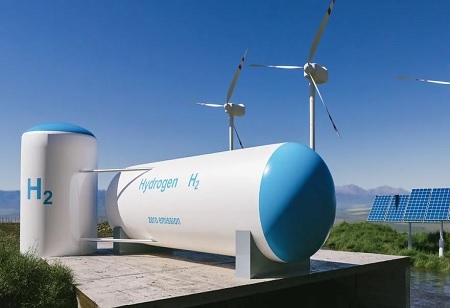India is in talks with the governments of other countries to export green hydrogen made in the South Asian nation, Reuters quoted an official of its foreign ministry. "We are in a position to make green hydrogen as our main source of energy in the future," Prabhat Kumar, an additional secretary of the external affairs ministry, said at an industry event.
Green hydrogen is made by breaking down water using electricity from renewable sources, which is considered crucial to decarbonize hard-to-abate heavy industries.The Indian government is planning a massive expansion of green hydrogen production to curb its dependence on energy imports and to wean the economy off fossil fuels to meet climate targets.
New Delhi is aiming for an annual production capacity of 25 million tons by 2047, people familiar with the plans told Bloomberg. However, the number could change going forward, depending on technology and the country’s demand outlook, they said. India’s current output of the fuel is very low and comes from a handful of pilot projects. While green hydrogen is regarded
as a potential panacea to cut emissions, there are still major challenges in scaling up the technology and making it cost-effective. It’s not certain demand growth will materialize, and the fuel may not become the first choice in transport and industry.
The potential to generate low-cost renewable energy in India, the world’s third biggest emitter of greenhouse gases, has been a driving force behind the government’s carbon-free hydrogen ambitions. India’s goal of getting to net zero by 2070 has found support from business tycoons, including Gautam Adani and Mukesh Ambani, as well as state-run energy giants like NTPC Ltd. and Indian Oil Corp.
Adani has pledged to spend $70 billion on clean energy assets, including green hydrogen, while Ambani’s Reliance Industries Ltd., one of India’s most valuable companies, plans to add production of solar panels, electrolyzers for clean hydrogen and rechargeable batteries. French oil giant TotalEnergies SE has agreed to partner with Adani on hydrogen in India. The government is considering more ways to spur the sector, including offering production-linked incentives to make electrolyzers.
Green hydrogen is made by splitting hydrogen and oxygen in water with the help of electrolyzers, powered by renewable electricity. The product can replace the use of hydrogen derived from some fossil fuels, in refineries and fertilizer plants. It has the potential to become an alternative to coal in steel mills and oil products in long-haul transport.
The green hydrogen targets are part of a broader strategy for 2047, the centenary year of India’s independence. The plan also includes measures to improve energy efficiency, overhaul power markets and expand manufacturing of renewable energy equipment, according to the people. Conglomerates run by India’s two richest men Gautam Adani and Mukesh Ambani along with state energy giants have committed large investments in the green hydrogen value chain, responding to Prime Minister Narendra Modi’s ambition to make the country a global powerhouse in this area.
